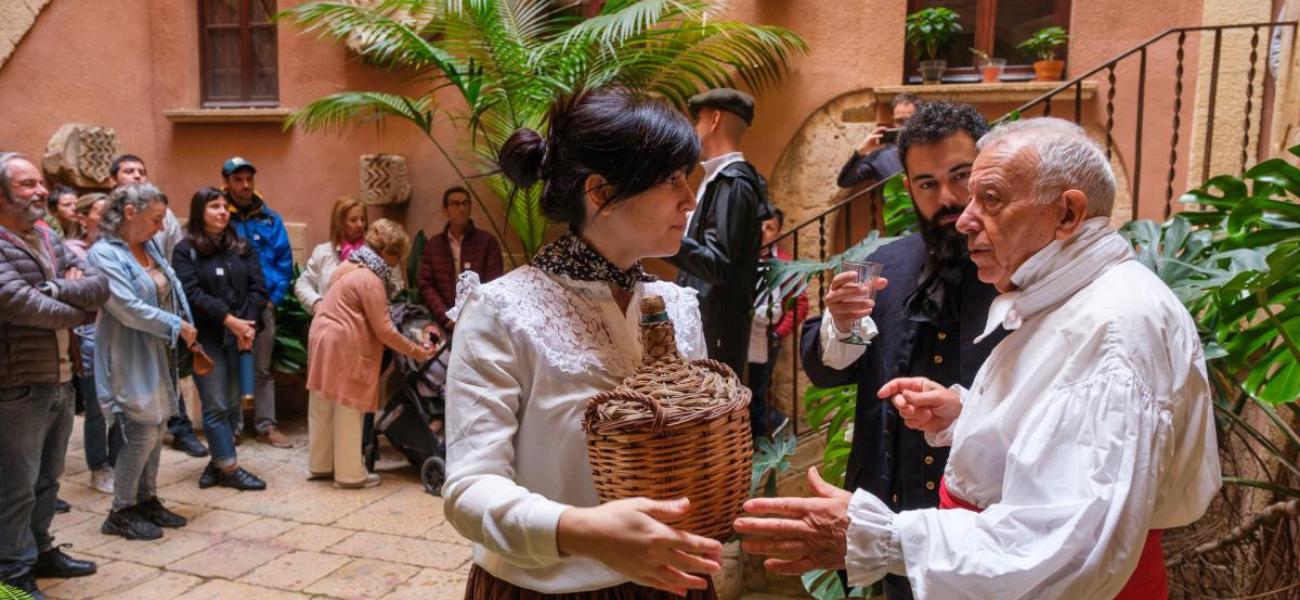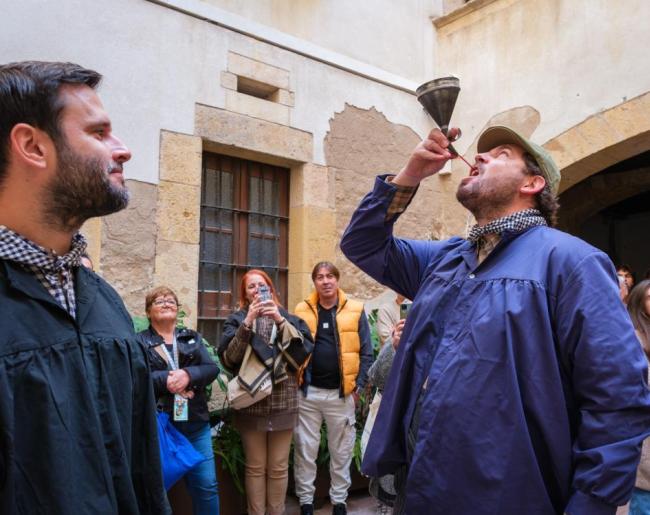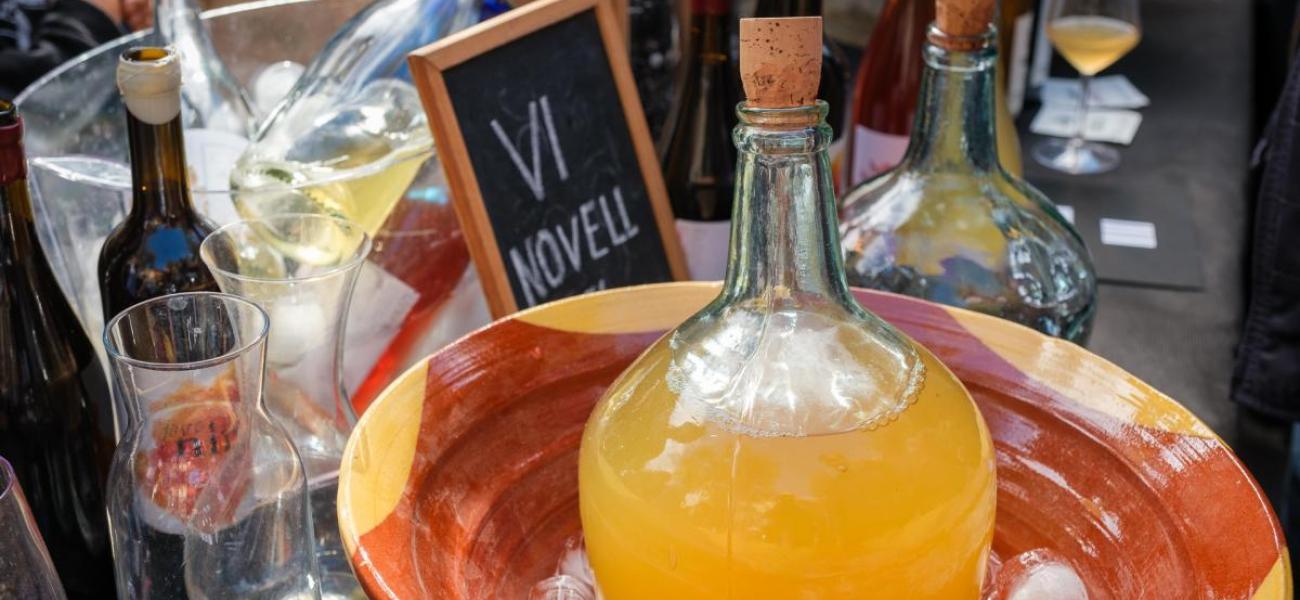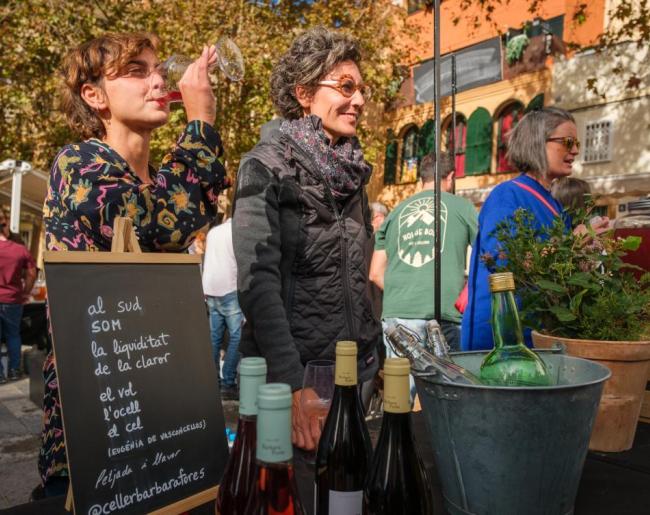We go back to the end of the 19th century, to any day in September. The Part Alta, the historic centre of Tarragona, is bustling with activity: the farmers have set up in Carrer de les Coques to sell what they have left from the market garden, the sound of horseshoes on the cobbles announces the arrival of horses and mules with the fruit of the grape harvest and the children wait anxiously to see if any grapes fall on them so that they can be quickly accounted for and let them crush the grapes before pressing. The sweet aroma of the must envelops the streets. Laughter, cordial phrases between neighbours and the sound of tools float in the air. The coopers assemble the wooden staves that shape the barrels, the glassmakers temper the glass that will become carafes and demijohns, the basket makers bend the wicker to make baskets that will protect the fragile glass containers and the brass makers make some very special funnels, with the lower cone angled. These are the funnels that will be used a few weeks later during the Embutada to celebrate the arrival of the new wine, generally during the first weeks of November. The proverbs of the time, especially those dedicated to Saint Martin on 11 November are full of allusions to the new wine: "Per Sant Martí, l'aigua al molí i tasta el vi” (Saint Martin, drink your wine and leave the water for the mill" or "Per Sant Martí, tot most és bon vi" (For Saint Martin, all must is good wine), are some examples.

This festival, which has been recorded since the distant 19th century, grew in parallel with the boom in the wine trade in Tarragona, when the city became an exporting power. Carrer Reial was full of warehouses and in the Part Alta there were forty or so small wineries that made wine in the ground floor of houses. Cal Trip, Pau del Blau, Ca l'Armengol - frequented by those who went to mass -, and the Delme and del Morillo or d'en Segura cellars, were some of the best known. In all of them, a pine branch was hung on the door when the new wine was ready. The Part Alta was divided into peasants and fishermen - the El Serrallo district did not yet exist -, the guilds that made up the groups of castellers (human towers) of the time. During the days of the Embutada, they would go round the cellars to lift some human towers and try to get a free glass of wine in exchange. Funnel in hand, the groups of friends and family members would play a fun game: they would pass the full funnel to each other, covering the outlet with a finger, to take it in turns to drink. Whoever ran out of wine had to pay for the next round. The strategy was served, there were those who took a long drink if they were the first to start the game, or a very short one, just a drop, if they were about to run out. This young wine, surely, was served directly from the cups where it had fermented. It was a wine made from all the varieties that the farmers had in the fields, seeking to make the best use of them rather than the quality of the result. It was fruity, closer to the must than to a wine with structure, and also seasonal, to be consumed over the next three or four months. With the disappearance of the last wineries in the historic centre of the city in the 1960s, the celebration of the Embutada also faded away.

© Rafa Pérez
Berna Ríos of Santa Teca, the association in charge of recovering this emblematic festival, says that in the first edition there were people who attended with one of those old funnels that they kept at home, some of them direct relatives of the winegrowers. L'Embutada, in its current format, links the world of wine with local gastronomy and culture. They try to work with producers of natural wine or with minimal intervention, who bring their proposals to present them to the public. Some winemakers do not have a young wine, but they all bring a wine that has already fermented and has not yet been bottled, allowing them to compare it with other vintages to see what it can become when the cycle is complete. "It is a luxury to taste a new wine, just born. But it is an even greater luxury to have all these producers who are valued in many countries around the world close by and to be able to taste their wines for just a couple of euros a glass", Berna Ríos points out.

There are novel wine festivals in France, such as the famous Beaujolais nouveau celebration; the Austrian heuriger hang the pine branch on the door when they have the year's wine ready, but the particularity of the funnel makes the Embutada festival unique, fully consolidated in Tarragona and with the potential to become an important date in the calendar for all lovers of wine culture and tradition.

© Rafa Pérez
The 8th Embutada will be held during the week of 4 to 10 November in the Plaça del Rei and the Espai Turisme on Carrer Major in Tarragona. More than 30 wineries are expected to take part and present their wines this year. They will be joined by restaurants such as El Cortijo, Portal22 and La Clotxa, which will offer a range of culinary delights. On Saturday and Sunday, a cultural tour of the historic centre, the Part Alta, will be offered. The tour will be led by Julio Villar Robles and will offer participants the opportunity to get to know the locations of old wineries, interesting sights and facts about the town, and the business activities that took place in the town's grand buildings, such as the old town hall. The event will also feature several musical performances as well as glass artisans, basket weavers and coopers. A series of cultural events related to the world of wine will be held throughout the week with the active participation of various associations and organisations from the city.